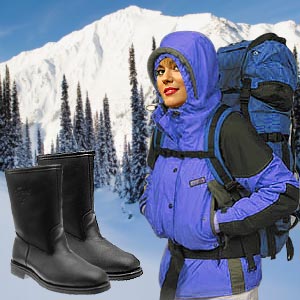Outdoor Clothing

If you are the outdoors kind of person, not passing by opportunities to go hiking or camping, you surely need comfortable and appropriate outdoor clothing to keep you safe and comfortable. Outdoor clothing should keep the wearer comfortable while serving its purpose to the fullest. Check out how to look for outdoor clothing for various weather conditions and outdoor activities.
Outdoor clothing basics
- Outdoor clothing should be worn in multi-layers (usually three layers). The inner/base layer acts as a moisture control. The middle layer or the insulation layer is used to provide warmth to the wearer. The outermost layer is called the shell and should be weatherproof - it is used to protect the wearer from the external factors of the environment, e.g. wind, rain, etc.
- When you decide your outdoor activity in a cold environment, use multi-layers of clothing for the middle/insulation layer. This will keep you warm and provide good insulation too. If you feel too warm after completing your activity you can wear the insulation layer or mid-layer clothing over the wind shirt (outermost layer). This will give you a comfortable feeling.
- Use a vapor barrier for the base layer as this will minimize moisture and help the insulation layer clothing to serve its best. The vapor barrier also helps in controlling moisture close to the skin thus bringing down perspiration. Cotton clothing for base layer can be bad as it cannot wick off moisture from the body. Cotton based base layer will suit you if you wish to maintain a low and cool body temperature. If you want a warm feeling choose synthetics, light weight polyester, etc. Use thermal underwear for cold climates.
- Insulation layer clothing offers warmth and retains body heat. That's why it is rightly named as the insulation layer. Take care that you don't use too many or too heavy clothing for this layer as this can make you sweat thus making you feel chilly. This layer of clothing should wick off moisture too. Commonly used insulation layer clothing is synthetic fleeces. Wool is good but takes time to dry up and is not as airy as synthetic fleeces.
- Outdoor clothing for the outermost layer or the shell layer should offer you protection from rain, wind, sleet, snow, etc. In general shell layer clothing must be both waterproof and windproof and also have some insulation properties. These clothes are fine for cold atmospheres; the wearer might feel hot in warm conditions. E.g. jackets, poncho, parka, etc.
- Outdoor clothing pants offer protection for the entire lower torso of the body. They also offer protection from bugs and thorns. Pants should make you feel comfortable and should be able to retain the warmth in the thigh portion. Pants should not come in way of your activity.
- Headwear such as hats and caps can be used to protect you from cold, rain and sun. In warm weather these headgears should provide good ventilation and during cold weather they must offer warmth.
- Gloves can be used as a part of outdoor clothing offering you protection from sun, cold and scratches.
- Footwear should match the outdoor activity chosen.
- Outdoor clothing for water or long time outdoor activities should be made from material that will dry up quickly. The material should not absorb too much of water.
- Outdoor clothing for expeditions should be light and should be easy to pack. Heavy clothing will be difficult to pack as well as carry about.
- Choose bright white shirts for hot-weather outdoor activities. It gives you a relatively cooler feel when compared to other colors.
- Choose outdoor clothing that permits good airflow; this will help your skin breathe with ease. Choose high air permeability fabrics.
- Choose vapor barrier socks, pants and shirts as they will make you feel warm while you are inactive and the surrounding temperature is below 0 F.
- Choose wind shirts as a part of the shell layer clothing, when combined with an apt base layer, they offer the best protection and comfort while being active. Wind shirts can also protect you from rain and dangerous bugs. Choose wind shirts that can breathe well and are also light in weight, e.g. unlined polyester jackets, unlined nylon jackets, ultra light jackets, etc.
Clothing for different outdoor activities
Outdoor clothing varies as per the outdoor activity you wish to pursue. Below given guide can assist you to make the right choice of clothes depending on the activity you choose.
- Perfect wicking
- Good insulation
- Quick drying
- Excellent breathing thus providing good ventilation
- Extended durability
- Excellent waterproof
- Excellent windproof
- Free movement, should not interfere with body movements
- Should be light and easy to pack
Clothes for camping:Shorts, floaters, and general clothing depending on the climatic conditions.
Clothes for snow: Choose to wear multi-layer clothing. In case you get wet, you can change the outer layer alone. Make sure the outermost layer of apparel you wear is both waterproof and windproof. This will keep you warm and also keep you dry. Bright clothes allow you to be seen. Ski pants are not made of very thick material as they can be worn with base layer pants during very cold days. Choose skiing clothes that are lightly insulated. Look for breathability and waterproof when choosing ski jackets. You can opt for detachable hood.
Clothes for high-altitude places:Choose thick clothes and wear multi-layer clothing rather than carrying heavy ones. Choose clothes that don't need to be changed often. Changing clothes can bring down your body temperature and also expose you to the chill.
Clothes for mountaineering and rock climbing: Wear clothes that lie perfectly on your body, they should not dangle and interfere with your activity, e.g. baggy clothing. Stretchable tights and a jacket should be taken compulsorily.
Clothes for wildlife adventure: Wear clothing that covers your body thoroughly. Wear full sleeves and thin cottons to let the breeze keep you cool. Full sleeves and full protection clothing help you ward off insects that can trigger any allergy in your body. Do not wear bright colored clothes as you might attract wild animals towards yourself.
Clothes for hiking: Carry clothes based on the period for hiking. Wear cotton clothes with long sleeves as they will protect your skin from scratches. Carry along a light jacket to protect yourself from the wind and rains.
Outdoor clothing for different climates
Hot and dry climates
- Choose loose fitting clothes for hot and dry climates.
- Loose fitting clothes breathe well and delay dehydration of the skin.
- Choose cotton clothes for your inner and outer layers of outdoor clothing.
- Wear long trousers to protect yourself from excessive sunlight.
- Wear light colored clothing as they have the tendency to reflect light and thus can maintain body temperature.
- Carry warm clothing as temperature might drop during the nights and you may want warm clothing then.
- Use woolen socks and good fitting hiking shoes.
- Use a hat with a wide-brim as it protects you from the sun.
Cold climates
- Use fleece or wool for all the base and insulating layers. Finish with a wind shell layer.
- Cotton should not be used as it does not wick moisture making you feel chill.
- Depending on your choice, add or reduce insulation layers.
- Wear gloves to protect your hands. Insulated gloves offer good protection for the hands. Use mittens above the gloves to offer extra protection for your hands.
- Wear a hat that can protect your ears.
- Use boots that suit cold climatic conditions.
- Carry extra pair of socks so that your feet will be warm and dry.
- Gaiters can offer extra protection from snow to your shoes and socks.
Maintenance of outdoor clothing
Maintaining outdoor clothing is as important as owning them. Follow these simple yet effective tips to retain them well for a long time:
- Keep the clothes clean. Wash them after every trip or give them at the laundry for cleaning.
- Follow the instructions in each garment while cleaning them. For e.g. drip dry garments should not be machine dried.
- While washing the clothes, zip the zipper at least ¾ ways through. This will prevent the zippers from breaking.
- Wash headgear like hats and caps separately, they also tend to get dirty with all the dirt and grime from the wearers head.
- Do not bleach outerwear clothes. Wash them in warm water setting and then tumble dry them.
- Attend to holes in the outdoor clothing immediately.
- Check the garment instruction label before you iron it.
Top of the Page: Outdoor Clothing
Tags:#outdoor clothing
 Shopping Guide
Shopping Guide Frugal Shopping Tips
Shopping Bags
Rolling Bags for Shopping
Gym Bag
Women Accessories
Texting Gloves
Women's Wallet
Belt Buckles
Clutch Bags
Women Personal Care
 Clothing Shopping
Clothing Shopping Sleeping Eye Mask
Laptop Backpack
Women's Briefcase
Women's Jacket
Women's Shoes
Summer Footwear Trends
Wide Width Shoes for Women
Women's Flat Shoes
Slippers for Women
Sarong
Summer Shoes
High Heels
Bridal Shoes
Designer Handbag
Outdoor Clothing
Shibori Design Techniques
Batik Fabric
Tie Dye Fabric
Plus Size Swim Wear
Facial Steamers
Stress Relief Products
Gadgets for Women
RFID Technology - RFID Application
Residential Thin Film Solar Panels
Renewable Energy Gadgets
Pepper Spray
Lift Chair
Laptop accessory
Device GPS Tracking
Plasma Television
Polarized Sun Glasses
Home Blood Pressure Monitor
Air Purifier
Car Shopping
Pet Carrier
Brochure Holder
Lanyard
Baby Stroller
Step Pedometer
Jewelry
 Jewelry and Ornaments
Jewelry and Ornaments Coral Jewelry
Replica Watch
Expensive Engagement Rings
Vintage Jewelry
Gifts and Occasions
 Valentine Day Gift Shopping
Valentine Day Gift Shopping Mother Day Gift
Handmade Baby Gift
Gifts under $50
Unusual Gift Ideas for Women
Baby Shower Gift
Unique Housewarming Gifts
Unique Wedding Favor
Winter Wedding Ideas
Holiday Shopping
Holiday Shopping Tips
Christmas Shopping Online Trip
Christmas Decoration Idea
Christmas Gift Gadget
Corporate Christmas Gift Idea
Stocking Stuffers
Christmas Candy Recipe
Currency Conversion
Top of the Page: Outdoor Clothing
Popularity Index: 101,499

